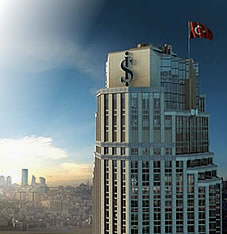Report: Economic Indicators of Turkey (March 2012)
Recently, the measures taken to overcome the crisis in Euro Area, which is cited as the main threat to global economic outlook, and the major central banks’ leaning towards monetary easing to support growth stimulated the capital inflows to emerging market economies.
Central Bank of Turkey narrowed the interest rate corridor by decreasing the O/N lending rate. CBRT cited the Fed’s, ECB’s and some emerging markets’ central banks’ monetary policy easing actions.
GROWTH
In December, industrial production index increased above expectations.According to Turkstat, industrial production index increased by 3.7% in December compared to the same month of the previous year, indicating a higher than expected speed. Thus, industrial production index rose by an average of %6.4 in the fourthquarter of 2011 compared to the same period of 2010. Annual average increase in the index was realized as 8.9% in 2011.
UNEMPLOYMENT RATE
According to the Household Labor Force Survey, the unemployment rate declined from %11.9 in 2010 to %9.8 in 2011. In the same period, non-agricultural unemployment rate was 12.4%, 2.4 percentage points below the previous year’s level. During 2011, total employment increased by 1 million 516 thousand personswhile non-agricultural employment rose by 1 million 56 thousand persons.
In this period, the share of the agricultural and construction sectors in total employment increased by 0.3 and 0.7 points, respectively, whereas the share of the services and industrial sectors declined by 0.5 and 0.4 points, respectively compared to the same period of 2010. In the coming period, further improvement in unemployment rate is expected to be limited due to the mild slowdown in the economy.foreign trade deficit.
In January, exports rose by 8.6% while imports increased by 2.8% compared to the same month of the previous year. Foreign trade deficit contracted by 4.7% to $7 billion during the same period. Although imports continued to grow at a moderate pace in the first month of the year, foreign trade deficit was realized slightly higher than the market expectations. The coverage ratio on the other hand, rose to 59.7% in January.
IMPORTS OF CAPITAL AND CONSUMPTION GOODS
In January, compared to the same month of the previous year, both intermediate and capital goods imports increased by 6% while consumption goods imports decreased by 20%. The decline in consumption goods imports points out that the domestic demand would follow a mild course in 2012.
CURRENT ACCOUNT DEFICIT
In December 2011, current account deficit (CAD) was realized as $6.6 billion in line with the market expectations. It was seen that the contraction in the current account deficit in November continued in December. Thus, 12-month cumulative deficit declined and was realized as $77.1 billion in 2011. The fact that the CAD has been narrowing, although gradually, was welcomed by the markets.
BUDGET
According to the recent figures released by Ministry of Finance, the budget discipline continued also in the first month of the year. In January, central government budget posted a surplus of TL1.7 billion while primary surplus was realized as TL7.1 billion. Compared to the previous year’s figures, budget surplus and primary surplus increased by 73.1% and 48.3%, respectively.
BANKING SECTOR
Deposit volume
According to BRSA’s Weekly Bulletin, as of February 24th, 2012, TL deposit volume decreased by 1.9% compared to the year-end. On the other hand, FX deposits in terms of USD have increased by 7.5% since the beginning of the year as a result of the depositors’ preference towards foreign currency in parallel to falling FX rates.
Credit volume
As of February 24th, 2012, TL credit volume increased by 1.1% compared to the year-end. During the same period, FX loans in USD terms also rose by 2.5%, while FX loans in terms of TL decreased by 5.2% compared to the year-end due to the appreciation of TL.
Securities portfolio…Banking sector securities portfolio increased by 0.9% as of February 24th, 2012, compared to the year-end of 2011. During this period, securities subject to repo transactions rose by 9%.
FX Position
Net FX position of the banking sector was realized as (+) $723 millionAs of February 24th, 2012, net FX position of the banking sector was realized as (+) $721 million. Banks’ on-balance sheet FX position was (-) $25,014 million while offbalance sheet FX position was (+) $25,734 million. The banking sector, which followed a cautious stance regarding the FX open position during 2011, has maintained this attitude in the first two months of 2012
EXPECTATIONS…
It is predicted that the problems originating from the Euro Area will remain on the top of the agenda in 2012 and the banks’ appetite for transferring the central bank funding outside the financial sector will be low. Thus, downside risks for global economic growth are expected to continue during 2012.
Under these conditions, it would take time for advanced countries to return back to normal from expansionary monetary policies.
In compliance to these developments, the Central Bank of Turkey narrowed the interest rate corridor and underlined that the cautious monetary policy stance will continue.
In parallel to the expectations that the elimination of the downside risks in the global economy might take time, it is foreseen that the moderate slowdown in domestic economic activity will continue. Hence, the deceleration of the annual increase in credit volume is expected to persist.
06.04.2012
compiled by Editor, BTT
Source; Isbank





